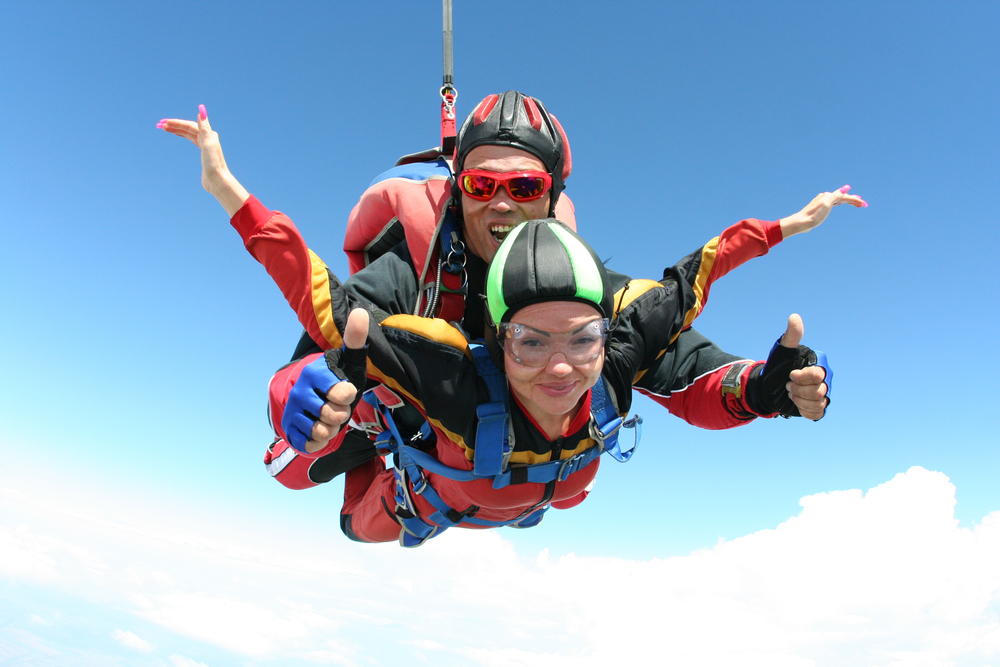There’s a lot of aspects that people worry about when it comes to skydiving.
One of the most common questions is about breathing while skydiving.
Can you breathe? Is there enough oxygen? Do you hold your breath the whole time?
Thankfully, there’s no real issue with breathing in skydiving. That said, it’s a common question for a reason, as some people do report some issues. In this article I’ll explain all the different reasons why you could ‘think’ you have trouble in a skydive, and how to avoid them.
Ready? Then let’s dive in.
Breathing Issues On My First Freefall
For anyone unfamiliar – I got my skydive licence following the static line method. This is where you start of jumping solo at low heights, and slowly build up to full skydives with some experience.
The first time I hit terminal velocity, I thought I couldn’t breathe.
Once you’re on to free fall kit in training, they let you jump progressively higher. We do a 3 second delay (count to 3, then pull), then a 5, 10, then 15 second delays.
It was my 15 second delay that really got me. It takes around 10 seconds to hit terminal velocity, so it was my first time fully experiencing the 120mph wind rushing upwards. And I thought I couldn’t breathe.
I’ll admit I started to panic a bit – as you do when hurtling through the sky without a breath. Thankfully I was still getting plenty of air in, it was just a mental state of panic.
In the jumps that followed I was glad to notice this didn’t quite happen again. Sure, breathing in a skydive isn’t like you’re chilling on the couch, but I never felt at risk of Oxygen.
The whole thing was a placebo. I think I ‘forgot’ to breathe due to the intensity of the situation, then suddenly started panicking. I somehow though that since the air was rushing past, it was going too fast to get into my lungs!
Thankfully, that’s totally untrue.
I wrote all of that to say I understand your worries. Breathing issues are scary, so let’s look at why they might happen – and how to solve them.
Why People Say They Can’t Breathe In A Skydive
Placebo Effect
This first category is the main culprit. And I feel I can really call it a placebo because I’ve experienced it myself.
You have to appreciate that in a skydive, your body is experiencing a pretty wild situation! There’s a heck of a lot going on, and we can forget to breathe normally. The second we feel we’re short of breath, we might panic and start breathing quick and shallow as a response.
The solution here is to remember this is a mental thing. Every skydiver is able to breathe – it’s entirely possible.
All you need to do is inhale deeply. Don’t overthink it, just breathe. And it’ll work.
The Wind Rush
As you’re reading this, take a good breath in. How does that feel? Calming, right?
Now imagine you’re being driven down the highway. You stick your head out the window, and feel the air rushing past you. Now double that speed, and think about breathing. It’s just a bit more chaotic!
That same feeling is how it’ll be in a skydive. The sheer force of air rushing past you can be overwhelming, and throw off your breathing. This is not a problem if you’re expecting it: veteran skydivers are all comfortable, it’s only newbies who get caught it.
Thankfully, by reading this guide, you are now expecting this to happen! Which means you’ll be prepared, and not surprised, if anything happens.
Less Oxygen Up High
The higher up we are, the less Oxygen that’s in the air.
The lack of Oxygen is why we need pressurized cabins in planes, or Oxygen tanks on HALO skydives.
So it’s true – breathing is a little more difficult high up due to a lower amount of Oxygen.
According to Hypoxico, Oxygen makes up 21% of the air at sea level.
When we’re at a basic jump height of 10,000ft, we only have 14.3% oxygen. That’s around 1/3rd less.
Looking at a bigger skydive of 14,000ft? Then you’re around 12.3% oxygen, or maybe 60% of normal amounts.
All of this being said, we don’t need any breathing equipment until we’re ABOVE 15,000ft.
Even though the air is a little less oxygen rich at skydive altitudes, it’s still entirely breathable.
If you’re worried, just make sure you’re taking deep breaths.
One great tip is to make sure you scream when you leave the plane! There’s just a *slight* chance you’ll be doing it anyway, so make that holler a real shriek to help make sure you take a big breath in afterwards.
Conclusion
Skydiving is a big deal, and there’s a lot to be concerned about before your first jump.
Breathing while skydiving is often one of those issues.
I hope this quick article has helped dispel any worries you had about being able to breath as you fall through the sky.
Remember – literally every other skydiver is able to breathe, so you can too. If you get worried, just focus up and take some deep breaths.
If this content has helped you, please consider checking out some of the related guides below.
Thanks for reading, and happy jumping!
Blue skies,
Craig
